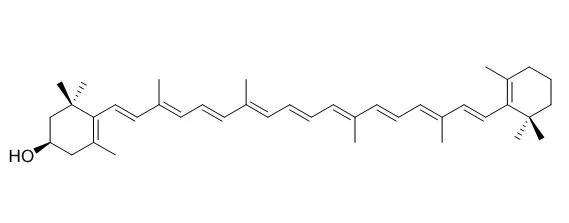| In vitro: |
| International journal of molecular medicine, 2005, 15(4):675-681. | | beta-Cryptoxanthin stimulates cell proliferation and transcriptional activity in osteoblastic MC3T3-E1 cells.[Reference: WebLink] | The carotenoid beta-Cryptoxanthin has been shown to have a stimulatory effect on bone formation in rat bone tissues in vitro. The effect of beta-Cryptoxanthin in osteoblastic cells in vitro was investigated.
METHODS AND RESULTS:
Osteoblastic MC3T3-E1 cells were cultured for 72 h in alpha-minimal essential medium containing 10% fetal bovine sereum (FBS) to reach subconfluent monolayers. After culture, the medium was changed, then beta-Cryptoxanthin (10(-8) to 10(-6) M) was added in the culture medium without FBS, and the cells were cultured for an additional 24, 48, or 72 h. The proliferation of osteoblastic cells was significantly enhanced in the presence of beta-Cryptoxanthin (10(-8) to 10(-6) M), when it was cultured for 48 or 72 h in medium containing 10% FBS. When osteoblastic cells with subconfluency were cultured for 48 or 72 h in FBS free-medium containing beta-Cryptoxanthin (10(-8) to 10(-6) M), alkaline phosphatase activity or deoxyribonucleic acid (DNA) content in the cells was significantly increased. Also, protein content in the cells was significantly increased by culture with 10(-6) M beta-Cryptoxanthin for 48 or 72 h. The effect of beta-Cryptoxanthin (10(-6) M) in increasing protein content, alkaline phosphatase activity, or DNA content in the cells was significantly blocked in the presence of staurosporine (10(-6) M) or PD98059 (10(-6) M), which is an inhibitor of protein kinases. The stimulatory effect of beta-Cryptoxanthin (10(-6) M) on cellular biochemical components was completely prevented in the presence of cycloheximide (10(-6) M), an inhibitor of protein synthesis, or 5,6-dichloro-1-beta-D-ribofuranosylbenzimidazole (DRB; 10(-9) M), an inhibitor of transcriptional activity. The expressions of insulin-like growth factor (IGF)-I and transforming growth factor (TGF)-beta1 mRNAs were demonstrated by reverse transcription-polymerase chain reaction (RT-PCR) analysis in osteoblastic cells using mouse IGF-I or TGF-beta1-specific primers. These expressions were significantly raised in the presence of beta-Cryptoxanthin (10(-6) M).
CONCLUSIONS:
This study demonstrates that beta-Cryptoxanthin has a stimulatory effect on cell proliferation and biochemical components in osteoclastic MC3T3-E1 cells, and that the carotenoid can stimulate transcriptional activity in the cells. |
|






 Cell. 2018 Jan 11;172(1-2):249-261.e12. doi: 10.1016/j.cell.2017.12.019.IF=36.216(2019)
Cell. 2018 Jan 11;172(1-2):249-261.e12. doi: 10.1016/j.cell.2017.12.019.IF=36.216(2019) Cell Metab. 2020 Mar 3;31(3):534-548.e5. doi: 10.1016/j.cmet.2020.01.002.IF=22.415(2019)
Cell Metab. 2020 Mar 3;31(3):534-548.e5. doi: 10.1016/j.cmet.2020.01.002.IF=22.415(2019) Mol Cell. 2017 Nov 16;68(4):673-685.e6. doi: 10.1016/j.molcel.2017.10.022.IF=14.548(2019)
Mol Cell. 2017 Nov 16;68(4):673-685.e6. doi: 10.1016/j.molcel.2017.10.022.IF=14.548(2019)